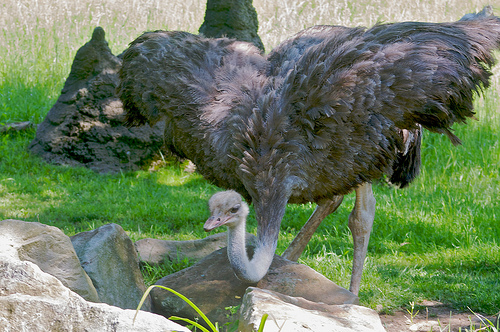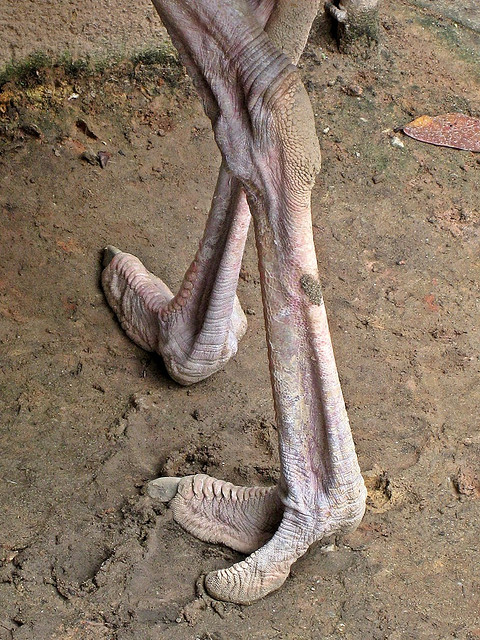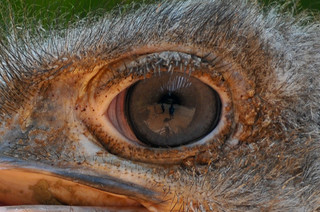
Adaptation
Since ostriches have been around for such a long time, they have had to make adaptations to ensure their continuous success as a species. The most prevalent adaptations that people notice would be their long, muscular legs. They are bipedal (two legged) and can reach high speeds when they need to. The ostrich also uses their legs to fight predators by kicking them! That great of a force could really deter an animal from continuing to pursue the ostrich for a meal. The ostrich is very successful in terrestrial locomotion. Research has been done on why these birds are so successful. And one of the conclusions: the toe. The ostrich uses pressure on different toes when starting to run, and then distributes the pressure to the tip of the toes. This allows them to reach such high speeds (Schaller, et al,. 2010). More research is being done on the ostrich, from it's legs, body build, all the way to adaptations in it's tongue! These are all relatively new studies, and are being elaborated on around the world.
An ostrich has been clocked at running at a full gallop of 40
miles per hour! Check out this video to see just how fast an
ostrich can run.
http://www.youtube.com/watch?v=1r-b8uY7C9E
One would assume that the ostrich flies because it
is a bird. But this is false advertising. Through
evolution, the ostrich has lost it's strong, stiff feathers that
would be in the wing area and tail area. It also does not
posses a keel (which is where the flight muscles would be attached). In actuality, the
wings of the o strich are very small in comparison to it's body mass.
In the place of these would be flight feathers is the growth of a
much softer, warm insulation of feathers. This plumage is used as a feathered insulating coat for when the temperatures drop.
Since the ostrich's environmental niche
ranges due to it's nutritional needs,
these adaptations have become key for them to survive! Two of
the wing fingers have claws on them. These claws are spur
like, and can be used as defense mechanisms if the ostrich is
provoked by a predator. The ostrich will fluff out it's wings
to make it seem bigger and more threatening to predators.
Along with fluffing their wings fro predators, the wings are used
for courting rituals. The wings
are lastly used for balance when running. The coloring of the
male and female feathers play a part in
reproduction, and caring for their young.
strich are very small in comparison to it's body mass.
In the place of these would be flight feathers is the growth of a
much softer, warm insulation of feathers. This plumage is used as a feathered insulating coat for when the temperatures drop.
Since the ostrich's environmental niche
ranges due to it's nutritional needs,
these adaptations have become key for them to survive! Two of
the wing fingers have claws on them. These claws are spur
like, and can be used as defense mechanisms if the ostrich is
provoked by a predator. The ostrich will fluff out it's wings
to make it seem bigger and more threatening to predators.
Along with fluffing their wings fro predators, the wings are used
for courting rituals. The wings
are lastly used for balance when running. The coloring of the
male and female feathers play a part in
reproduction, and caring for their young.
Another huge adaptation that the ostrich has to ensure it's species success is that it has thick eyelids. Having this thick layer of epidermis to protect the eye is a necessary characteristic to have when facing intense sand storms that come with living in desert regions.
The ostriches have beaks. This is a characteristic that it shares with many of it's Avian ancestors and relatives. But their nostrils are located more forward on the beak. Inside the beak, the ostrich has a set of sharp teeth. These are used for ingesting small animals that they prey on for nutrients. These are essential for their diet.
Like it's Avian relatives, the ostrich has a
respiratory system build for the bird class. Ostriches use
lungs, as well as an air sac system that originates in the thorax
and extends into hollow bones (necessary for birds of flight).
Since the ostrich is not a bird of flight, only some of the bones
are hollow. For instance, it's lower legs are not hollow, but
contain a thick cortex.
Ostriches use this air sac system to reduce their body heat via
panting (they cannot sweat because they lack mammary glands).
The wind pipe, trachea, is larger then most birds, allowing more air
passage. this is an adaptation made specifically so they can
run!
Without these adaptations, it would be impossible for the ostrich to be as successful as it has been. Not only for it's own species, but with how it interacts with other organisms.
So, is it a myth or the truth that the ostrich
buries it's head in the sand? Well, experts at the
San Diego Zoo say no. What is really happening then? Well,
if an ostrich feels like it is in danger within it's
niche, and it does not have enough time to
run away, it uses another response: play dead. Almost like
playing possum, it will drop to the ground and remain still while
it's neck and head lie on the ground. Due to the coloring on
it's head and neck resembling light sand, it would appear the head
is not visible. MYTH BUSTED!

